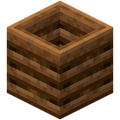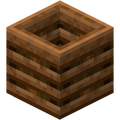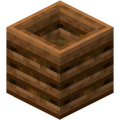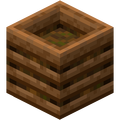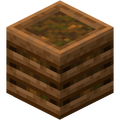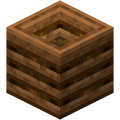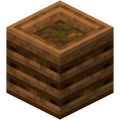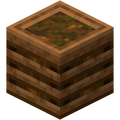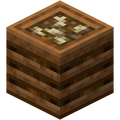A composter is a block that converts some biological material into bone meal. It also serves as a farmer villager's job site block.
Obtaining
Composters can be broken using any tool, though an axe is the fastest. The composter does not retain the compost inside; instead, it drops empty.
| Block | Composter | |
|---|---|---|
| Hardness | 0.6 | |
| Tool | ||
| Breaking time[A] | ||
| Default | 0.9 | |
| Wooden | 0.45 | |
| Stone | 0.25 | |
| Iron | 0.15 | |
| Diamond | 0.15 | |
| Netherite | 0.1 | |
| Golden | 0.1 | |
- ↑ Times are for unenchanted tools as wielded by players with no status effects, measured in seconds. For more information, see Breaking § Speed.
Crafting
Composters can only be crafted using proper wooden slabs, not petrified oak slabs.
Natural generation
Composters generate in village farms.
Usage
Composters can be used to recycle food and plant items (excluding bamboo[1], poisonous potatoes[2], dead bushes[3], meat, and fish) into bone meal. To do so, the player must use any of a selection of items on the composter. When an adjacent comparator is facing away from the composter, a comparator signal strength of up to 8 is emitted depending on the fullness of the block. Composters appear to have an empty interior. As such, entities can enter and exit a composter through the top, but not the sides or bottom. The composter has a "floor", whose height depends on the fullness. When the composter is completely empty, this floor is slightly above the block below, and when it is completely full, there is a slight dip on top. When the composter’s fullness increases, any entities inside are pushed up accordingly.[Bedrock Edition only]
Composting
The composter can be filled with compost, which is done by adding compostable items to it. When successfully adding an item, a green particle (![]() ) appears. The table below lists supported items, which have different levels of compost-ability. The higher the percentage of an item, the more likely it is for it to add another layer of compost. Each layer of compost has a podzol-like appearance. When the composter reaches the 7th layer of compost, the compost changes appearance indicating that bone meal can be collected by using the composter a final time.
) appears. The table below lists supported items, which have different levels of compost-ability. The higher the percentage of an item, the more likely it is for it to add another layer of compost. Each layer of compost has a podzol-like appearance. When the composter reaches the 7th layer of compost, the compost changes appearance indicating that bone meal can be collected by using the composter a final time.
The following table shows the items that can be used in a composter, the percent chance for an item to add a level of compost, and the average number of items needed to fill a composter. Smaller pieces (individual pieces of wheat, melon slices, etc.) produce more compost than the blocks or other items that can be made from them. The exception is cookies, because each recipe produces 8 cookies, and together those give more than 3 times the compost.
| Composting chance (per item) | |||||
|---|---|---|---|---|---|
| 30% | 50% | 65% | 85% | 100% | |
| Items | |||||
| Average items to complete compost | |||||
| 23.33 | 14.00 | 10.77 | 8.24 | 7.00 | |
| Average compost yield (per stack) | |||||
| 2.74 | 4.57 | 5.94 | 7.77 | 9.14 | |
Changing profession
If a village has a composter that has not been claimed by a villager, any resident villager who has not already chosen a job site block has a chance to change their profession to farmer.
Redstone component
A composter can act as a power source for a redstone comparator. With a composter behind it (either directly, or separated by an unpowered solid block), a comparator outputs a signal strength between 0 and 8, proportional to how full the composter is: 0 for empty, 1 for 1⁄7 full, 2 for 2⁄7 full, and so on to 6. 7 is for completely full but the bone meal is not ready to collect, and 8 for completely full and the bone meal is ready to collect. However, if there is a block between the composter and comparator, the comparator does not immediately update.
Hoppers
Composters can interact with hoppers. A hopper directly below a composter pulls bone meal from it. A hopper or dropper facing downward directly above a composter pushes items into it. See Hopper § Redstone component for more details.
Hoppers cannot interact with the sides of a composter.
Fuel
A composter can be used as fuel in a furnace to smelt 1.5 items.
Note Blocks
Composters can be placed under note blocks to produce "bass" sounds.
Sounds
Generic
| Sound | Subtitles | Source | Description | Resource location | Translation key | Volume | Pitch | Attenuation distance |
|---|---|---|---|---|---|---|---|---|
| Block broken | Blocks | Once the block has broken | block | subtitles | 1.0 | 0.8 | 16 | |
| Block placed | Blocks | When the block is placed | block | subtitles | 1.0 | 0.8 | 16 | |
| Block breaking | Blocks | While the block is in the process of being broken | block | subtitles | 0.25 | 0.5 | 16 | |
| None[sound 1] | Entity-Dependent | Falling on the block with fall damage | block | None[sound 1] | 0.5 | 0.75 | 16 | |
| Footsteps | Entity-Dependent | Walking on the block | block | subtitles | 0.15 | 1.0 | 16 |
| Sound | Source | Description | Resource location | Volume | Pitch |
|---|---|---|---|---|---|
| Blocks | Once the block has broken | dig | 1.0 | 0.8-1.0 | |
| Blocks | When the block is placed | dig | 1.0 | 0.8 | |
| Blocks | While the block is in the process of being broken | hit | 0.23 | 0.5 | |
| Players | Falling on the block with fall damage | fall | 0.4 | 1.0 | |
| Players | Walking on the block | step | 0.3 | 1.0 | |
| Players | Jumping from the block | jump | 0.12 | 1.0 | |
| Players | Falling on the block without fall damage | land | 0.18 | 1.0 |
Unique
| Sound | Subtitles | Source | Description | Resource location | Translation key | Volume | Pitch | Attenuation distance |
|---|---|---|---|---|---|---|---|---|
| Composter empties | Blocks | When a composter is emptied | block | subtitles | 1.0 | 1.0 | 16 | |
| Composter filled | Blocks | When adding to a composter | block | subtitles | 0.3 | 0.8 | 16 | |
| Composter filled | Blocks | When successfully adding to a composter | block | subtitles | 1.0 | 1.0 | 16 | |
| Composter composts | Blocks | When composting completes | block | subtitles | 1.0 | 1.0 | 16 | |
| Farmer works | Friendly Creatures | Randomly while a farmer is working | entity | subtitles | 1.0 | 0.8-1.2 | 16 |
| Sound | Source | Description | Resource location | Volume | Pitch |
|---|---|---|---|---|---|
| Blocks | When a composter is emptied | block | 1.0 | 1.0 | |
| Blocks | When adding to a composter | block | 1.3 | 0.8 | |
| Blocks | When adding to a composter [sound 1] | item | 1.0 | 0.9-1.1 | |
| Blocks | When successfully adding to a composter | block | 1.3 | 1.0 | |
| Blocks | When composting completes | block | 1.0 | 1.0 | |
| Blocks | Randomly while a farmer is working | block | 1.3 | 0.8 |
Data values
ID
| Name | Identifier | Form | Translation key |
|---|---|---|---|
| Composter | composter | Block & Item | block.minecraft.composter |
| Name | Identifier | Numeric ID | Form | Item ID[i 1] | Translation key |
|---|---|---|---|---|---|
| Composter | composter | 468 | Block & Giveable Item[i 2] | Identical[i 3] | tile.composter.name |
Block states
- Composter with different compost levels
| Name | Default value | Allowed values | Description |
|---|---|---|---|
| level | 0 | 012345678 | When at level 8, bone meal is able to be collected from the composter. |
| Name | Metadata Bits | Default value | Allowed values | Values for Metadata Bits |
Description |
|---|---|---|---|---|---|
| composter_fill_level | 0x10x20x40x8 | 0 | 012345678 | 012345678 | When at level 8, bone meal is able to be collected from the composter. |
History
| Java Edition | |||||||
|---|---|---|---|---|---|---|---|
| 1.14 | 19w03a | ||||||
| Composter blocks are found in the Miscellaneous tab in the Creative inventory.[4] | |||||||
The crafting recipe of composters is 4 fences and 3 planks.
| |||||||
| 19w03b | All mushroom blocks can now be used in composters. | ||||||
| 19w04a | Composters now spawn in village farms. | ||||||
| 19w05a | The chances of composters have been changed from 10/20/50/80/100% to 30/50/65/85/100%. | ||||||
| 19w11a | Composters now serve as farmer villagers' job site block. | ||||||
| 1.15 | 19w45a | The crafting recipe of composters has been changed to match Bedrock Edition.
| |||||
| 1.16 | 20w06a | Moved composter blocks to the Decoration Blocks tab from the Miscellaneous tab in the Creative inventory.[4] | |||||
| 20w15a | Weeping vines, twisting vines, roots, nether sprouts, fungi, nether wart, nether wart blocks, and warped wart blocks can now be composted. | ||||||
| pre3 | Shroomlights can now be composted.[5] | ||||||
| 1.17 | 21w05a | Azalea, dripleaves, hanging roots, glow berries, moss blocks, moss carpets and spore blossoms can now be composted. | |||||
| 21w11a | Glow lichen can now be composted. | ||||||
| 1.19 | 22w11a | Mangrove propagule can now be composted. | |||||
| 22w12a | Mangrove leaves can now be composted.[6] | ||||||
| 22w15a | Mangrove roots can now be composted.[7] | ||||||
| 1.20 (Experimental) | 23w07a | Torchflowers, torchflower seeds, and pink petals can now be composted. | |||||
| Bedrock Edition | |||||||
| 1.10.0 | beta 1.10.0.3 | ||||||
| Composters are currently available only through Experimental Gameplay. | |||||||
The crafting recipe of composters is 7 wooden slabs.
| |||||||
| 1.11.0 | beta 1.11.0.1 | Added functionality like in Java Edition. | |||||
| beta 1.11.0.3 | Composters now support hopper placement. | ||||||
| 1.16.0 | beta 1.16.0.57 | Weeping vines, twisting vines, roots, nether sprouts, fungi, nether wart, nether wart blocks, and warped wart blocks can now be composted. | |||||
| 1.16.100 | beta 1.16.100.55 | Shroomlight can now be composted. | |||||
| 1.16.220 | beta 1.16.220.52 | Azalea, dripleaves, glow berries, moss blocks, moss carpet and spore blossoms can now be composted. | |||||
| 1.17.0 | beta 1.16.230.50 | Hanging roots and glow lichen can now be composted. | |||||
| beta 1.16.230.54 | Small dripleaf can now be composted. | ||||||
| PlayStation 4 Edition | |||||||
| 1.91 | |||||||
Issues
Issues relating to "Composter" are maintained on the bug tracker. Report issues there.
Trivia
- The compost texture is based on the podzol texture.
- If planting crops specifically for composting, potatoes produce somewhat more than beets, carrots, or wheat. However, melons offer nearly the same yield per field space, and do not require replanting after harvest.
- Since dried kelp has a 30% chance of composting one level, two dried kelp have a 51% of composting at least one level. This is higher than the 50% dried kelp blocks have, so it is better to break up a dried kelp block before composting. In the same way, you should also break up hay bales before composting.
Gallery
Screenshots
-
A composter generated in a village
-
A full and partially filled composter in a farm
-
An official screenshot of a composter used on Minecraft.net.[8]
Renders
- Java Edition
- Bedrock Edition
References
External Links
- Block of the Week: Composter – Minecraft.net on March 23, 2023





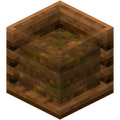
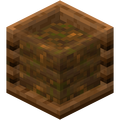

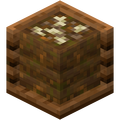


![An official screenshot of a composter used on Minecraft.net.[8]](https://static.wikia.nocookie.net/minecraft_gamepedia/images/d/d9/BotM_Composter.jpg/revision/latest/scale-to-width-down/120?cb=20230524043512)
